Theory and Research on Transformational Leadership: A Critical Review
VerifiedAdded on 2023/06/12
|17
|6283
|170
Essay
AI Summary
This essay presents a critical review of transformational leadership, exploring its background, evolution, philosophy, and approach to leadership challenges, particularly within the healthcare sector. It discusses the core principles of transformational leadership, highlighting its focus on motivating and inspiring followers to achieve organizational goals through individual and social system changes. The review also addresses critiques of transformational leadership, including potential shortcomings like lack of focus, burnout, disruption in employee practices, and the risk of despotic leadership. The essay concludes by evaluating the application of transformational leadership within the healthcare sector, emphasizing its potential benefits and challenges in improving patient care and organizational effectiveness. The document is available on Desklib, a platform offering study tools for students.
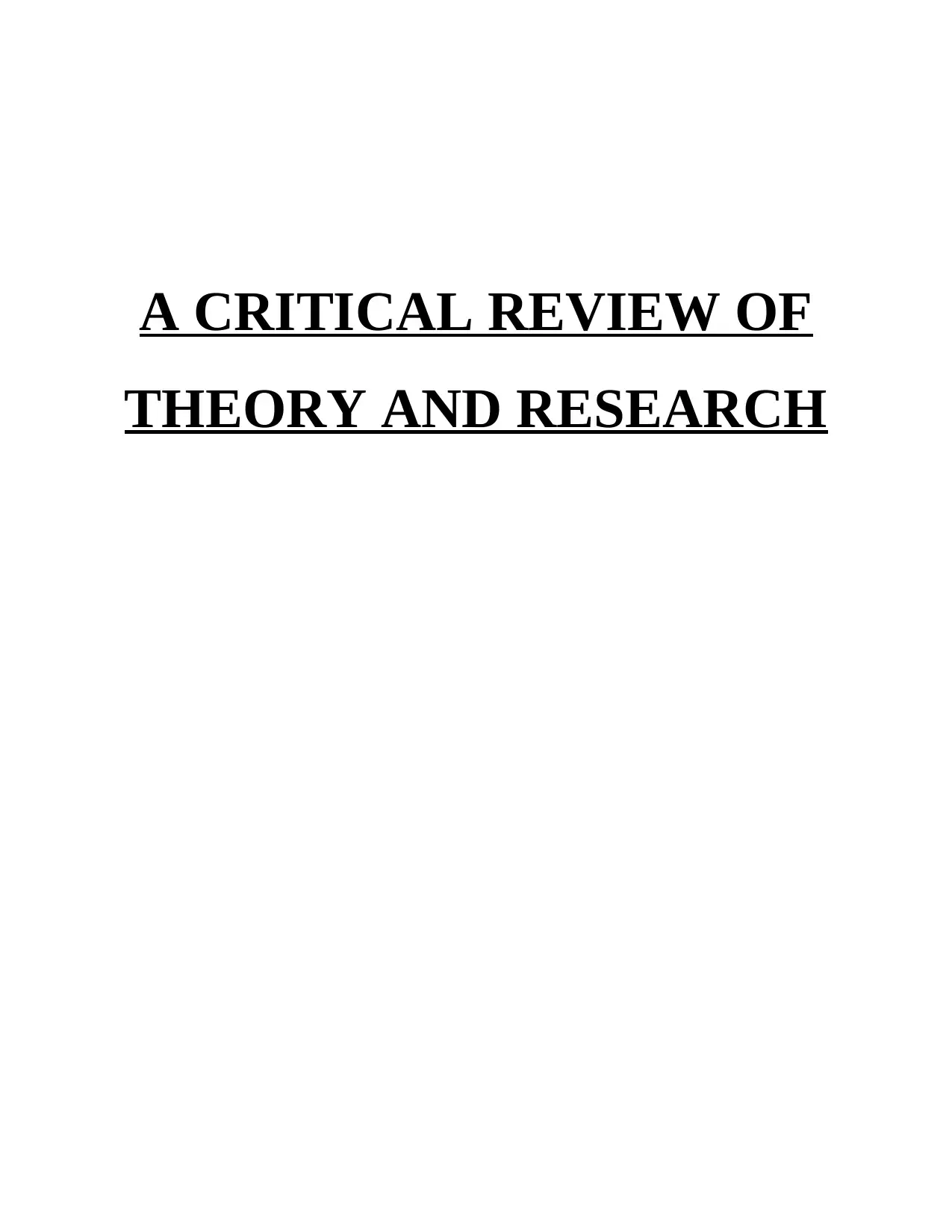
A CRITICAL REVIEW OF
THEORY AND RESEARCH
THEORY AND RESEARCH
Paraphrase This Document
Need a fresh take? Get an instant paraphrase of this document with our AI Paraphraser
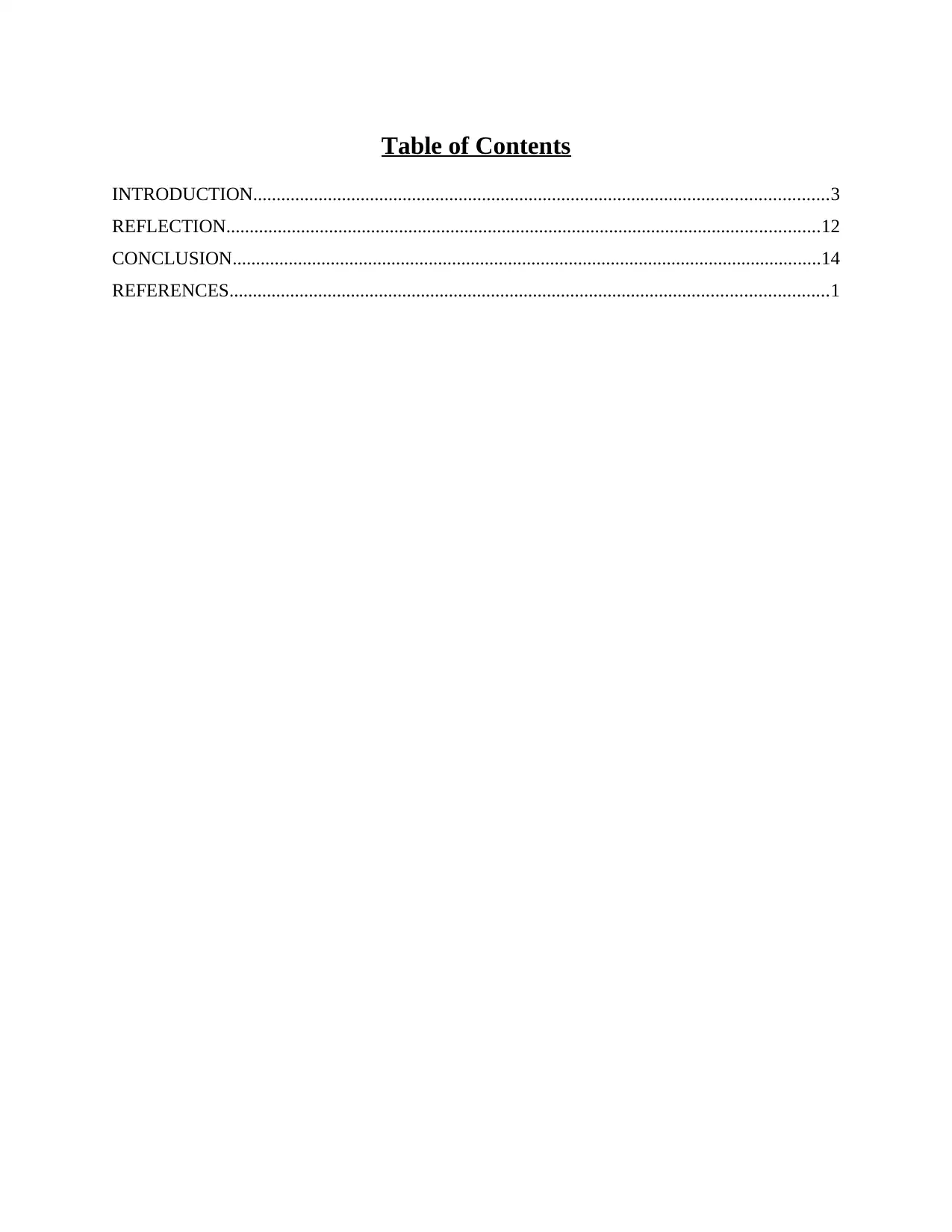
Table of Contents
INTRODUCTION...........................................................................................................................3
REFLECTION...............................................................................................................................12
CONCLUSION..............................................................................................................................14
REFERENCES................................................................................................................................1
INTRODUCTION...........................................................................................................................3
REFLECTION...............................................................................................................................12
CONCLUSION..............................................................................................................................14
REFERENCES................................................................................................................................1
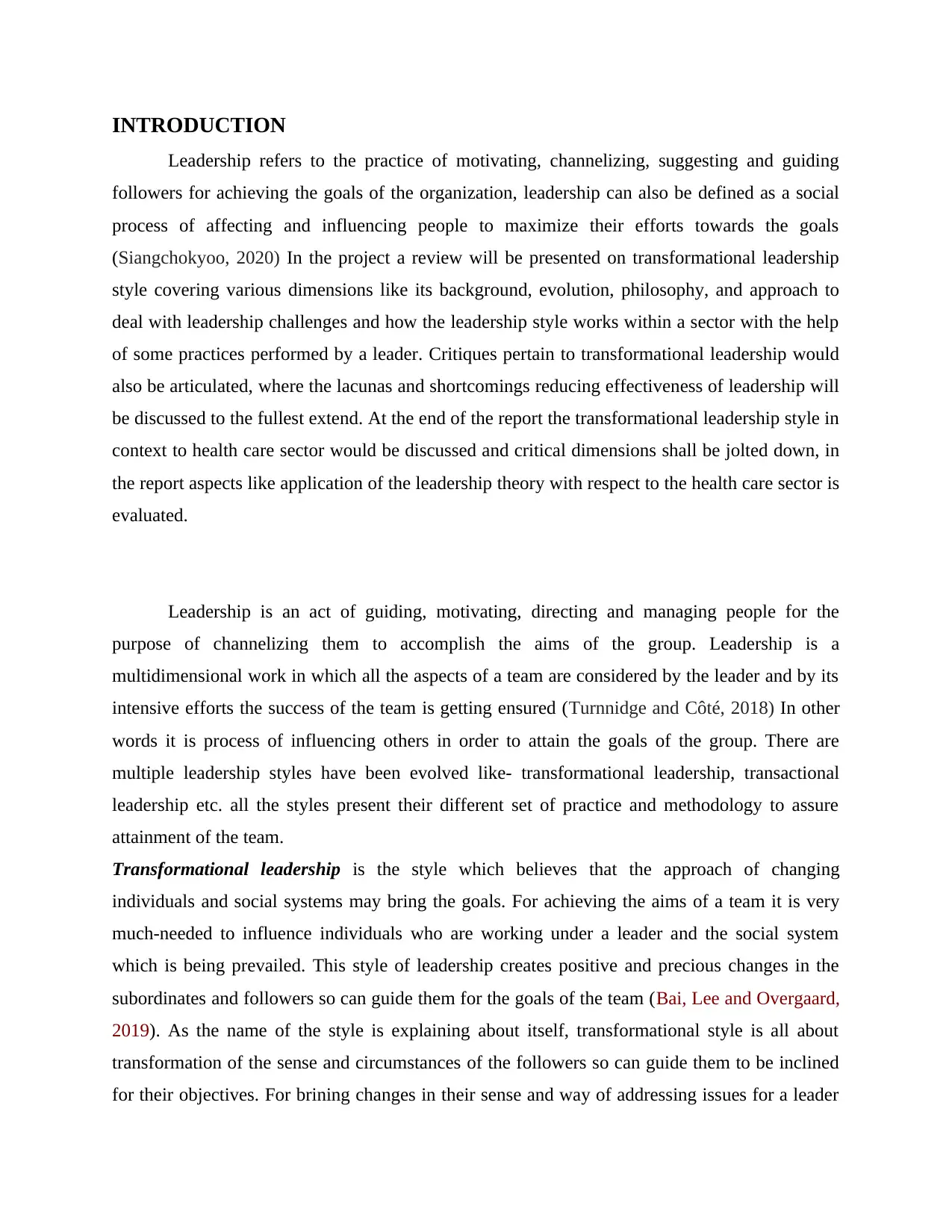
INTRODUCTION
Leadership refers to the practice of motivating, channelizing, suggesting and guiding
followers for achieving the goals of the organization, leadership can also be defined as a social
process of affecting and influencing people to maximize their efforts towards the goals
(Siangchokyoo, 2020) In the project a review will be presented on transformational leadership
style covering various dimensions like its background, evolution, philosophy, and approach to
deal with leadership challenges and how the leadership style works within a sector with the help
of some practices performed by a leader. Critiques pertain to transformational leadership would
also be articulated, where the lacunas and shortcomings reducing effectiveness of leadership will
be discussed to the fullest extend. At the end of the report the transformational leadership style in
context to health care sector would be discussed and critical dimensions shall be jolted down, in
the report aspects like application of the leadership theory with respect to the health care sector is
evaluated.
Leadership is an act of guiding, motivating, directing and managing people for the
purpose of channelizing them to accomplish the aims of the group. Leadership is a
multidimensional work in which all the aspects of a team are considered by the leader and by its
intensive efforts the success of the team is getting ensured (Turnnidge and Côté, 2018) In other
words it is process of influencing others in order to attain the goals of the group. There are
multiple leadership styles have been evolved like- transformational leadership, transactional
leadership etc. all the styles present their different set of practice and methodology to assure
attainment of the team.
Transformational leadership is the style which believes that the approach of changing
individuals and social systems may bring the goals. For achieving the aims of a team it is very
much-needed to influence individuals who are working under a leader and the social system
which is being prevailed. This style of leadership creates positive and precious changes in the
subordinates and followers so can guide them for the goals of the team (Bai, Lee and Overgaard,
2019). As the name of the style is explaining about itself, transformational style is all about
transformation of the sense and circumstances of the followers so can guide them to be inclined
for their objectives. For brining changes in their sense and way of addressing issues for a leader
Leadership refers to the practice of motivating, channelizing, suggesting and guiding
followers for achieving the goals of the organization, leadership can also be defined as a social
process of affecting and influencing people to maximize their efforts towards the goals
(Siangchokyoo, 2020) In the project a review will be presented on transformational leadership
style covering various dimensions like its background, evolution, philosophy, and approach to
deal with leadership challenges and how the leadership style works within a sector with the help
of some practices performed by a leader. Critiques pertain to transformational leadership would
also be articulated, where the lacunas and shortcomings reducing effectiveness of leadership will
be discussed to the fullest extend. At the end of the report the transformational leadership style in
context to health care sector would be discussed and critical dimensions shall be jolted down, in
the report aspects like application of the leadership theory with respect to the health care sector is
evaluated.
Leadership is an act of guiding, motivating, directing and managing people for the
purpose of channelizing them to accomplish the aims of the group. Leadership is a
multidimensional work in which all the aspects of a team are considered by the leader and by its
intensive efforts the success of the team is getting ensured (Turnnidge and Côté, 2018) In other
words it is process of influencing others in order to attain the goals of the group. There are
multiple leadership styles have been evolved like- transformational leadership, transactional
leadership etc. all the styles present their different set of practice and methodology to assure
attainment of the team.
Transformational leadership is the style which believes that the approach of changing
individuals and social systems may bring the goals. For achieving the aims of a team it is very
much-needed to influence individuals who are working under a leader and the social system
which is being prevailed. This style of leadership creates positive and precious changes in the
subordinates and followers so can guide them for the goals of the team (Bai, Lee and Overgaard,
2019). As the name of the style is explaining about itself, transformational style is all about
transformation of the sense and circumstances of the followers so can guide them to be inclined
for their objectives. For brining changes in their sense and way of addressing issues for a leader
⊘ This is a preview!⊘
Do you want full access?
Subscribe today to unlock all pages.

Trusted by 1+ million students worldwide
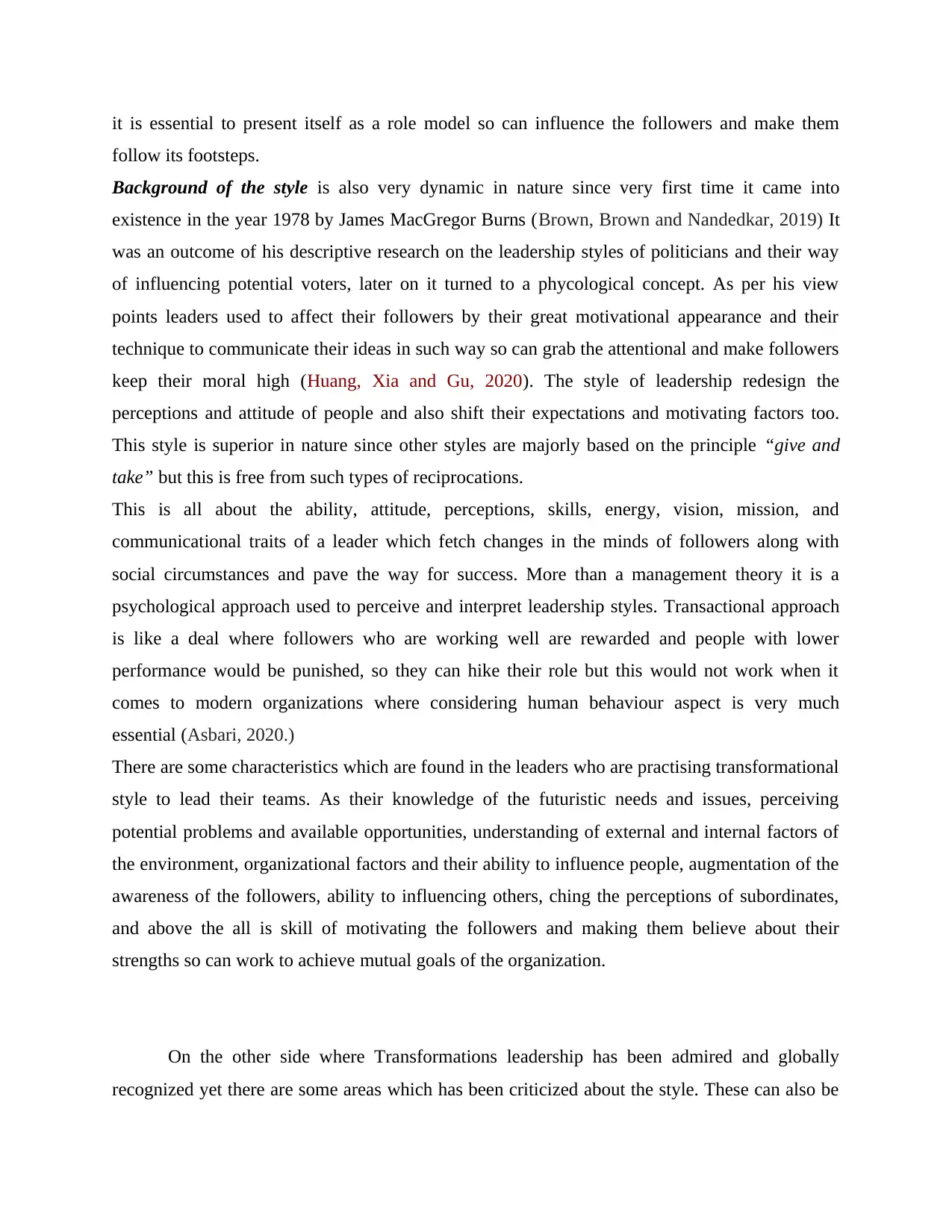
it is essential to present itself as a role model so can influence the followers and make them
follow its footsteps.
Background of the style is also very dynamic in nature since very first time it came into
existence in the year 1978 by James MacGregor Burns (Brown, Brown and Nandedkar, 2019) It
was an outcome of his descriptive research on the leadership styles of politicians and their way
of influencing potential voters, later on it turned to a phycological concept. As per his view
points leaders used to affect their followers by their great motivational appearance and their
technique to communicate their ideas in such way so can grab the attentional and make followers
keep their moral high (Huang, Xia and Gu, 2020). The style of leadership redesign the
perceptions and attitude of people and also shift their expectations and motivating factors too.
This style is superior in nature since other styles are majorly based on the principle “give and
take” but this is free from such types of reciprocations.
This is all about the ability, attitude, perceptions, skills, energy, vision, mission, and
communicational traits of a leader which fetch changes in the minds of followers along with
social circumstances and pave the way for success. More than a management theory it is a
psychological approach used to perceive and interpret leadership styles. Transactional approach
is like a deal where followers who are working well are rewarded and people with lower
performance would be punished, so they can hike their role but this would not work when it
comes to modern organizations where considering human behaviour aspect is very much
essential (Asbari, 2020.)
There are some characteristics which are found in the leaders who are practising transformational
style to lead their teams. As their knowledge of the futuristic needs and issues, perceiving
potential problems and available opportunities, understanding of external and internal factors of
the environment, organizational factors and their ability to influence people, augmentation of the
awareness of the followers, ability to influencing others, ching the perceptions of subordinates,
and above the all is skill of motivating the followers and making them believe about their
strengths so can work to achieve mutual goals of the organization.
On the other side where Transformations leadership has been admired and globally
recognized yet there are some areas which has been criticized about the style. These can also be
follow its footsteps.
Background of the style is also very dynamic in nature since very first time it came into
existence in the year 1978 by James MacGregor Burns (Brown, Brown and Nandedkar, 2019) It
was an outcome of his descriptive research on the leadership styles of politicians and their way
of influencing potential voters, later on it turned to a phycological concept. As per his view
points leaders used to affect their followers by their great motivational appearance and their
technique to communicate their ideas in such way so can grab the attentional and make followers
keep their moral high (Huang, Xia and Gu, 2020). The style of leadership redesign the
perceptions and attitude of people and also shift their expectations and motivating factors too.
This style is superior in nature since other styles are majorly based on the principle “give and
take” but this is free from such types of reciprocations.
This is all about the ability, attitude, perceptions, skills, energy, vision, mission, and
communicational traits of a leader which fetch changes in the minds of followers along with
social circumstances and pave the way for success. More than a management theory it is a
psychological approach used to perceive and interpret leadership styles. Transactional approach
is like a deal where followers who are working well are rewarded and people with lower
performance would be punished, so they can hike their role but this would not work when it
comes to modern organizations where considering human behaviour aspect is very much
essential (Asbari, 2020.)
There are some characteristics which are found in the leaders who are practising transformational
style to lead their teams. As their knowledge of the futuristic needs and issues, perceiving
potential problems and available opportunities, understanding of external and internal factors of
the environment, organizational factors and their ability to influence people, augmentation of the
awareness of the followers, ability to influencing others, ching the perceptions of subordinates,
and above the all is skill of motivating the followers and making them believe about their
strengths so can work to achieve mutual goals of the organization.
On the other side where Transformations leadership has been admired and globally
recognized yet there are some areas which has been criticized about the style. These can also be
Paraphrase This Document
Need a fresh take? Get an instant paraphrase of this document with our AI Paraphraser
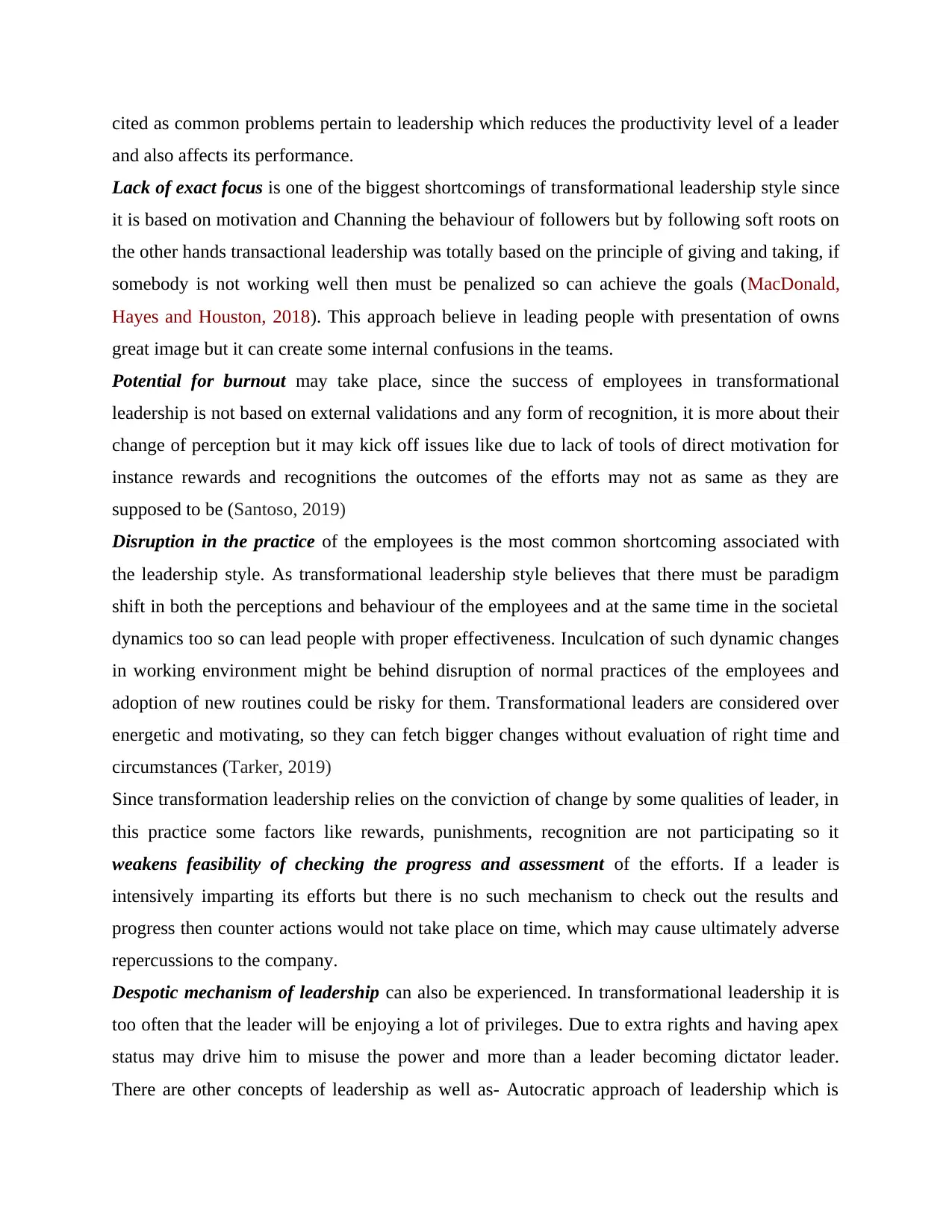
cited as common problems pertain to leadership which reduces the productivity level of a leader
and also affects its performance.
Lack of exact focus is one of the biggest shortcomings of transformational leadership style since
it is based on motivation and Channing the behaviour of followers but by following soft roots on
the other hands transactional leadership was totally based on the principle of giving and taking, if
somebody is not working well then must be penalized so can achieve the goals (MacDonald,
Hayes and Houston, 2018). This approach believe in leading people with presentation of owns
great image but it can create some internal confusions in the teams.
Potential for burnout may take place, since the success of employees in transformational
leadership is not based on external validations and any form of recognition, it is more about their
change of perception but it may kick off issues like due to lack of tools of direct motivation for
instance rewards and recognitions the outcomes of the efforts may not as same as they are
supposed to be (Santoso, 2019)
Disruption in the practice of the employees is the most common shortcoming associated with
the leadership style. As transformational leadership style believes that there must be paradigm
shift in both the perceptions and behaviour of the employees and at the same time in the societal
dynamics too so can lead people with proper effectiveness. Inculcation of such dynamic changes
in working environment might be behind disruption of normal practices of the employees and
adoption of new routines could be risky for them. Transformational leaders are considered over
energetic and motivating, so they can fetch bigger changes without evaluation of right time and
circumstances (Tarker, 2019)
Since transformation leadership relies on the conviction of change by some qualities of leader, in
this practice some factors like rewards, punishments, recognition are not participating so it
weakens feasibility of checking the progress and assessment of the efforts. If a leader is
intensively imparting its efforts but there is no such mechanism to check out the results and
progress then counter actions would not take place on time, which may cause ultimately adverse
repercussions to the company.
Despotic mechanism of leadership can also be experienced. In transformational leadership it is
too often that the leader will be enjoying a lot of privileges. Due to extra rights and having apex
status may drive him to misuse the power and more than a leader becoming dictator leader.
There are other concepts of leadership as well as- Autocratic approach of leadership which is
and also affects its performance.
Lack of exact focus is one of the biggest shortcomings of transformational leadership style since
it is based on motivation and Channing the behaviour of followers but by following soft roots on
the other hands transactional leadership was totally based on the principle of giving and taking, if
somebody is not working well then must be penalized so can achieve the goals (MacDonald,
Hayes and Houston, 2018). This approach believe in leading people with presentation of owns
great image but it can create some internal confusions in the teams.
Potential for burnout may take place, since the success of employees in transformational
leadership is not based on external validations and any form of recognition, it is more about their
change of perception but it may kick off issues like due to lack of tools of direct motivation for
instance rewards and recognitions the outcomes of the efforts may not as same as they are
supposed to be (Santoso, 2019)
Disruption in the practice of the employees is the most common shortcoming associated with
the leadership style. As transformational leadership style believes that there must be paradigm
shift in both the perceptions and behaviour of the employees and at the same time in the societal
dynamics too so can lead people with proper effectiveness. Inculcation of such dynamic changes
in working environment might be behind disruption of normal practices of the employees and
adoption of new routines could be risky for them. Transformational leaders are considered over
energetic and motivating, so they can fetch bigger changes without evaluation of right time and
circumstances (Tarker, 2019)
Since transformation leadership relies on the conviction of change by some qualities of leader, in
this practice some factors like rewards, punishments, recognition are not participating so it
weakens feasibility of checking the progress and assessment of the efforts. If a leader is
intensively imparting its efforts but there is no such mechanism to check out the results and
progress then counter actions would not take place on time, which may cause ultimately adverse
repercussions to the company.
Despotic mechanism of leadership can also be experienced. In transformational leadership it is
too often that the leader will be enjoying a lot of privileges. Due to extra rights and having apex
status may drive him to misuse the power and more than a leader becoming dictator leader.
There are other concepts of leadership as well as- Autocratic approach of leadership which is
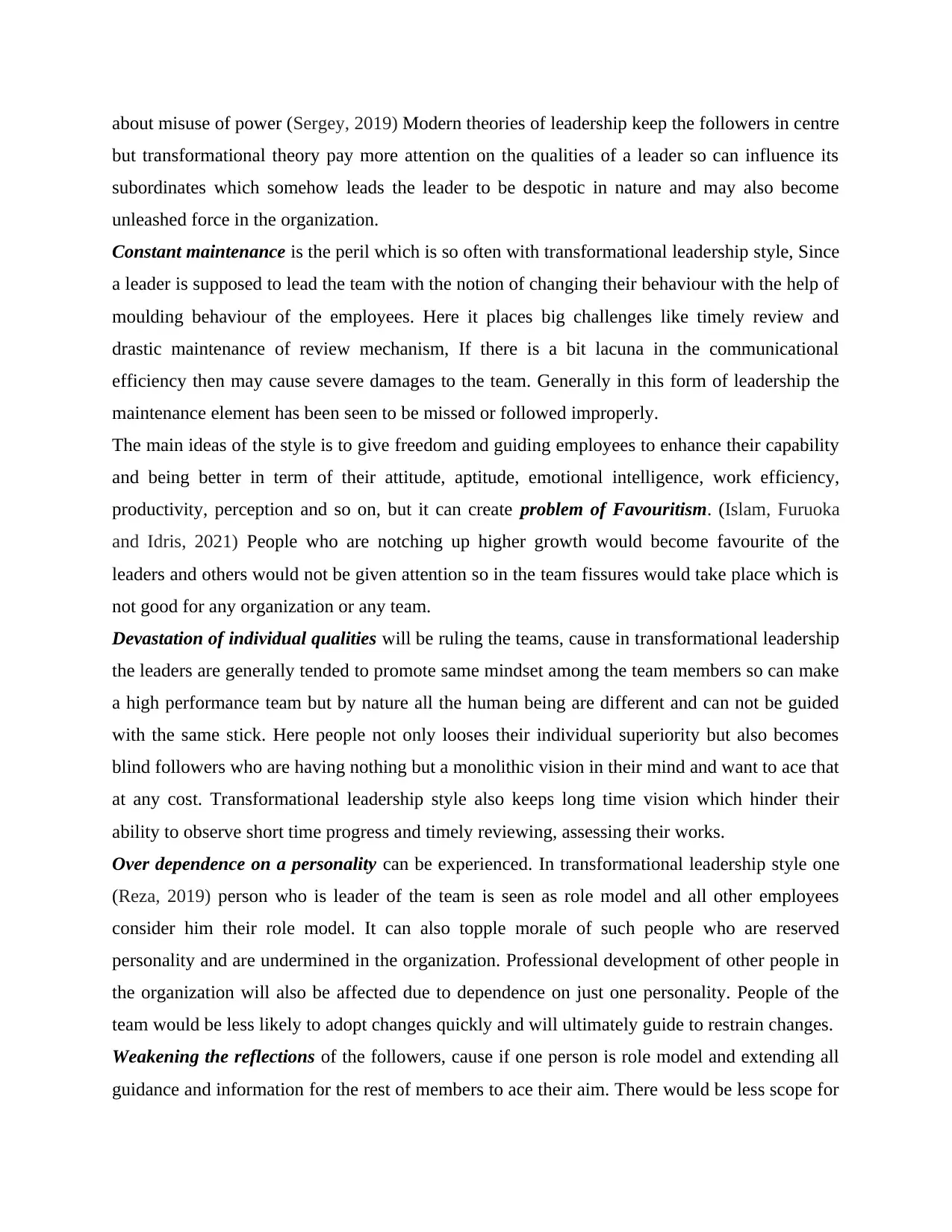
about misuse of power (Sergey, 2019) Modern theories of leadership keep the followers in centre
but transformational theory pay more attention on the qualities of a leader so can influence its
subordinates which somehow leads the leader to be despotic in nature and may also become
unleashed force in the organization.
Constant maintenance is the peril which is so often with transformational leadership style, Since
a leader is supposed to lead the team with the notion of changing their behaviour with the help of
moulding behaviour of the employees. Here it places big challenges like timely review and
drastic maintenance of review mechanism, If there is a bit lacuna in the communicational
efficiency then may cause severe damages to the team. Generally in this form of leadership the
maintenance element has been seen to be missed or followed improperly.
The main ideas of the style is to give freedom and guiding employees to enhance their capability
and being better in term of their attitude, aptitude, emotional intelligence, work efficiency,
productivity, perception and so on, but it can create problem of Favouritism. (Islam, Furuoka
and Idris, 2021) People who are notching up higher growth would become favourite of the
leaders and others would not be given attention so in the team fissures would take place which is
not good for any organization or any team.
Devastation of individual qualities will be ruling the teams, cause in transformational leadership
the leaders are generally tended to promote same mindset among the team members so can make
a high performance team but by nature all the human being are different and can not be guided
with the same stick. Here people not only looses their individual superiority but also becomes
blind followers who are having nothing but a monolithic vision in their mind and want to ace that
at any cost. Transformational leadership style also keeps long time vision which hinder their
ability to observe short time progress and timely reviewing, assessing their works.
Over dependence on a personality can be experienced. In transformational leadership style one
(Reza, 2019) person who is leader of the team is seen as role model and all other employees
consider him their role model. It can also topple morale of such people who are reserved
personality and are undermined in the organization. Professional development of other people in
the organization will also be affected due to dependence on just one personality. People of the
team would be less likely to adopt changes quickly and will ultimately guide to restrain changes.
Weakening the reflections of the followers, cause if one person is role model and extending all
guidance and information for the rest of members to ace their aim. There would be less scope for
but transformational theory pay more attention on the qualities of a leader so can influence its
subordinates which somehow leads the leader to be despotic in nature and may also become
unleashed force in the organization.
Constant maintenance is the peril which is so often with transformational leadership style, Since
a leader is supposed to lead the team with the notion of changing their behaviour with the help of
moulding behaviour of the employees. Here it places big challenges like timely review and
drastic maintenance of review mechanism, If there is a bit lacuna in the communicational
efficiency then may cause severe damages to the team. Generally in this form of leadership the
maintenance element has been seen to be missed or followed improperly.
The main ideas of the style is to give freedom and guiding employees to enhance their capability
and being better in term of their attitude, aptitude, emotional intelligence, work efficiency,
productivity, perception and so on, but it can create problem of Favouritism. (Islam, Furuoka
and Idris, 2021) People who are notching up higher growth would become favourite of the
leaders and others would not be given attention so in the team fissures would take place which is
not good for any organization or any team.
Devastation of individual qualities will be ruling the teams, cause in transformational leadership
the leaders are generally tended to promote same mindset among the team members so can make
a high performance team but by nature all the human being are different and can not be guided
with the same stick. Here people not only looses their individual superiority but also becomes
blind followers who are having nothing but a monolithic vision in their mind and want to ace that
at any cost. Transformational leadership style also keeps long time vision which hinder their
ability to observe short time progress and timely reviewing, assessing their works.
Over dependence on a personality can be experienced. In transformational leadership style one
(Reza, 2019) person who is leader of the team is seen as role model and all other employees
consider him their role model. It can also topple morale of such people who are reserved
personality and are undermined in the organization. Professional development of other people in
the organization will also be affected due to dependence on just one personality. People of the
team would be less likely to adopt changes quickly and will ultimately guide to restrain changes.
Weakening the reflections of the followers, cause if one person is role model and extending all
guidance and information for the rest of members to ace their aim. There would be less scope for
⊘ This is a preview!⊘
Do you want full access?
Subscribe today to unlock all pages.

Trusted by 1+ million students worldwide
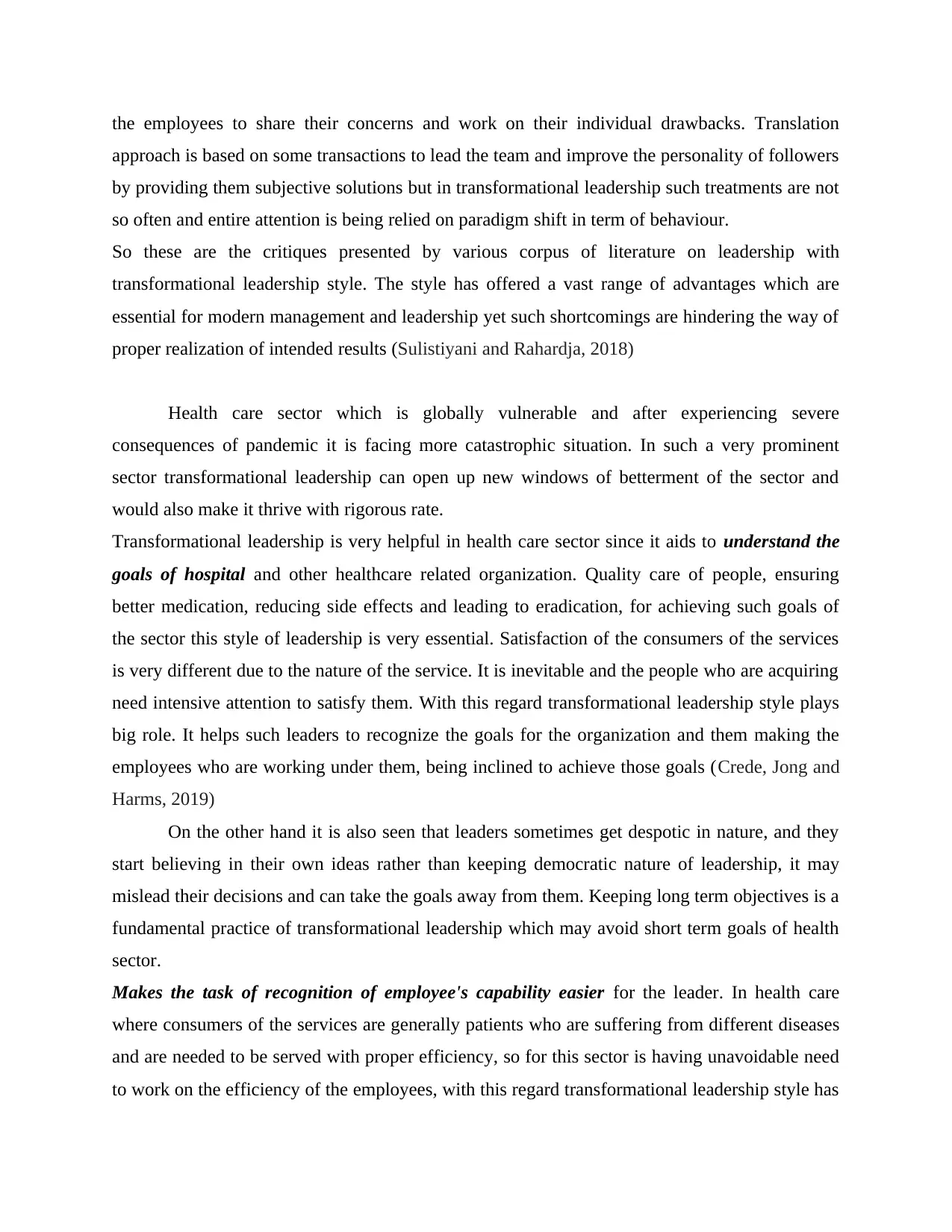
the employees to share their concerns and work on their individual drawbacks. Translation
approach is based on some transactions to lead the team and improve the personality of followers
by providing them subjective solutions but in transformational leadership such treatments are not
so often and entire attention is being relied on paradigm shift in term of behaviour.
So these are the critiques presented by various corpus of literature on leadership with
transformational leadership style. The style has offered a vast range of advantages which are
essential for modern management and leadership yet such shortcomings are hindering the way of
proper realization of intended results (Sulistiyani and Rahardja, 2018)
Health care sector which is globally vulnerable and after experiencing severe
consequences of pandemic it is facing more catastrophic situation. In such a very prominent
sector transformational leadership can open up new windows of betterment of the sector and
would also make it thrive with rigorous rate.
Transformational leadership is very helpful in health care sector since it aids to understand the
goals of hospital and other healthcare related organization. Quality care of people, ensuring
better medication, reducing side effects and leading to eradication, for achieving such goals of
the sector this style of leadership is very essential. Satisfaction of the consumers of the services
is very different due to the nature of the service. It is inevitable and the people who are acquiring
need intensive attention to satisfy them. With this regard transformational leadership style plays
big role. It helps such leaders to recognize the goals for the organization and them making the
employees who are working under them, being inclined to achieve those goals (Crede, Jong and
Harms, 2019)
On the other hand it is also seen that leaders sometimes get despotic in nature, and they
start believing in their own ideas rather than keeping democratic nature of leadership, it may
mislead their decisions and can take the goals away from them. Keeping long term objectives is a
fundamental practice of transformational leadership which may avoid short term goals of health
sector.
Makes the task of recognition of employee's capability easier for the leader. In health care
where consumers of the services are generally patients who are suffering from different diseases
and are needed to be served with proper efficiency, so for this sector is having unavoidable need
to work on the efficiency of the employees, with this regard transformational leadership style has
approach is based on some transactions to lead the team and improve the personality of followers
by providing them subjective solutions but in transformational leadership such treatments are not
so often and entire attention is being relied on paradigm shift in term of behaviour.
So these are the critiques presented by various corpus of literature on leadership with
transformational leadership style. The style has offered a vast range of advantages which are
essential for modern management and leadership yet such shortcomings are hindering the way of
proper realization of intended results (Sulistiyani and Rahardja, 2018)
Health care sector which is globally vulnerable and after experiencing severe
consequences of pandemic it is facing more catastrophic situation. In such a very prominent
sector transformational leadership can open up new windows of betterment of the sector and
would also make it thrive with rigorous rate.
Transformational leadership is very helpful in health care sector since it aids to understand the
goals of hospital and other healthcare related organization. Quality care of people, ensuring
better medication, reducing side effects and leading to eradication, for achieving such goals of
the sector this style of leadership is very essential. Satisfaction of the consumers of the services
is very different due to the nature of the service. It is inevitable and the people who are acquiring
need intensive attention to satisfy them. With this regard transformational leadership style plays
big role. It helps such leaders to recognize the goals for the organization and them making the
employees who are working under them, being inclined to achieve those goals (Crede, Jong and
Harms, 2019)
On the other hand it is also seen that leaders sometimes get despotic in nature, and they
start believing in their own ideas rather than keeping democratic nature of leadership, it may
mislead their decisions and can take the goals away from them. Keeping long term objectives is a
fundamental practice of transformational leadership which may avoid short term goals of health
sector.
Makes the task of recognition of employee's capability easier for the leader. In health care
where consumers of the services are generally patients who are suffering from different diseases
and are needed to be served with proper efficiency, so for this sector is having unavoidable need
to work on the efficiency of the employees, with this regard transformational leadership style has
Paraphrase This Document
Need a fresh take? Get an instant paraphrase of this document with our AI Paraphraser
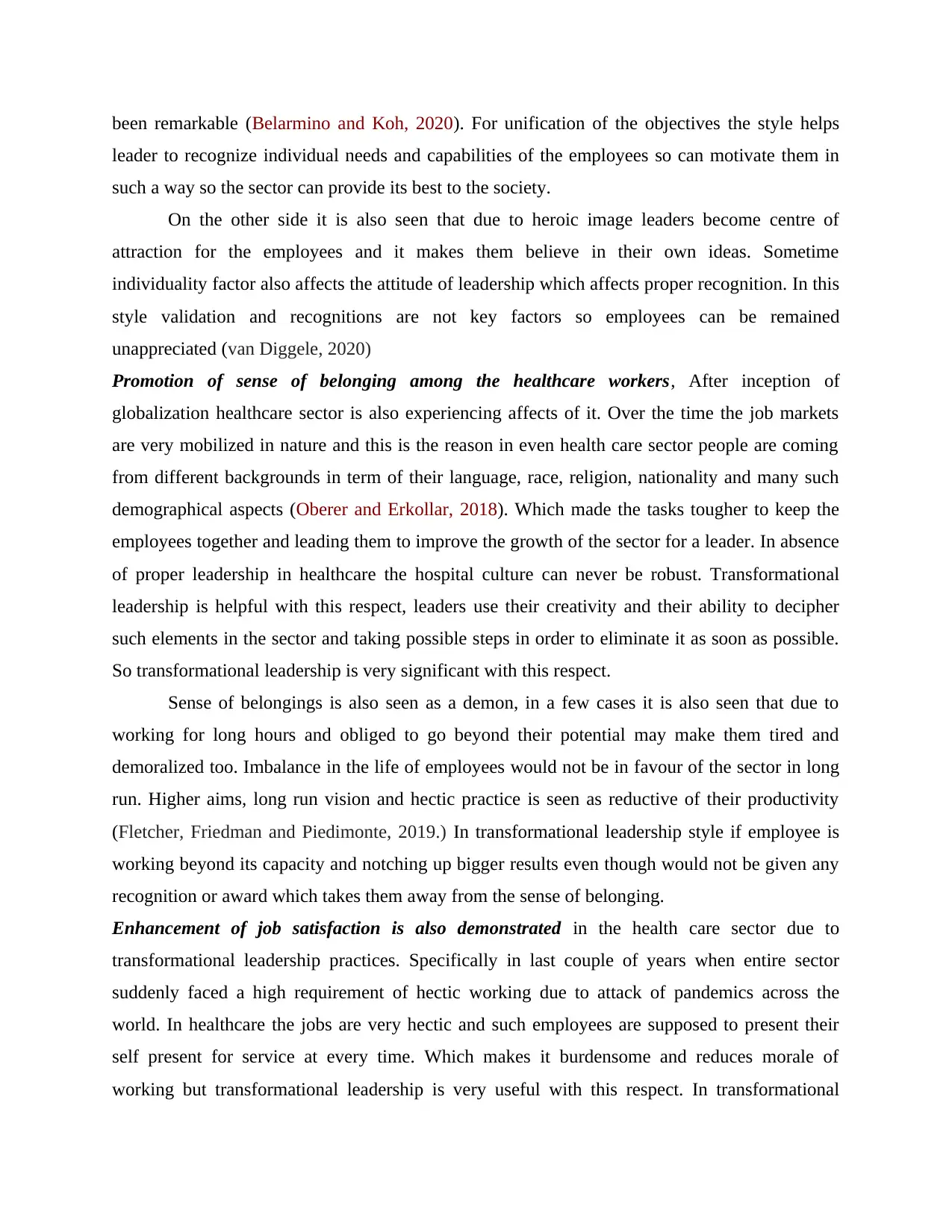
been remarkable (Belarmino and Koh, 2020). For unification of the objectives the style helps
leader to recognize individual needs and capabilities of the employees so can motivate them in
such a way so the sector can provide its best to the society.
On the other side it is also seen that due to heroic image leaders become centre of
attraction for the employees and it makes them believe in their own ideas. Sometime
individuality factor also affects the attitude of leadership which affects proper recognition. In this
style validation and recognitions are not key factors so employees can be remained
unappreciated (van Diggele, 2020)
Promotion of sense of belonging among the healthcare workers, After inception of
globalization healthcare sector is also experiencing affects of it. Over the time the job markets
are very mobilized in nature and this is the reason in even health care sector people are coming
from different backgrounds in term of their language, race, religion, nationality and many such
demographical aspects (Oberer and Erkollar, 2018). Which made the tasks tougher to keep the
employees together and leading them to improve the growth of the sector for a leader. In absence
of proper leadership in healthcare the hospital culture can never be robust. Transformational
leadership is helpful with this respect, leaders use their creativity and their ability to decipher
such elements in the sector and taking possible steps in order to eliminate it as soon as possible.
So transformational leadership is very significant with this respect.
Sense of belongings is also seen as a demon, in a few cases it is also seen that due to
working for long hours and obliged to go beyond their potential may make them tired and
demoralized too. Imbalance in the life of employees would not be in favour of the sector in long
run. Higher aims, long run vision and hectic practice is seen as reductive of their productivity
(Fletcher, Friedman and Piedimonte, 2019.) In transformational leadership style if employee is
working beyond its capacity and notching up bigger results even though would not be given any
recognition or award which takes them away from the sense of belonging.
Enhancement of job satisfaction is also demonstrated in the health care sector due to
transformational leadership practices. Specifically in last couple of years when entire sector
suddenly faced a high requirement of hectic working due to attack of pandemics across the
world. In healthcare the jobs are very hectic and such employees are supposed to present their
self present for service at every time. Which makes it burdensome and reduces morale of
working but transformational leadership is very useful with this respect. In transformational
leader to recognize individual needs and capabilities of the employees so can motivate them in
such a way so the sector can provide its best to the society.
On the other side it is also seen that due to heroic image leaders become centre of
attraction for the employees and it makes them believe in their own ideas. Sometime
individuality factor also affects the attitude of leadership which affects proper recognition. In this
style validation and recognitions are not key factors so employees can be remained
unappreciated (van Diggele, 2020)
Promotion of sense of belonging among the healthcare workers, After inception of
globalization healthcare sector is also experiencing affects of it. Over the time the job markets
are very mobilized in nature and this is the reason in even health care sector people are coming
from different backgrounds in term of their language, race, religion, nationality and many such
demographical aspects (Oberer and Erkollar, 2018). Which made the tasks tougher to keep the
employees together and leading them to improve the growth of the sector for a leader. In absence
of proper leadership in healthcare the hospital culture can never be robust. Transformational
leadership is helpful with this respect, leaders use their creativity and their ability to decipher
such elements in the sector and taking possible steps in order to eliminate it as soon as possible.
So transformational leadership is very significant with this respect.
Sense of belongings is also seen as a demon, in a few cases it is also seen that due to
working for long hours and obliged to go beyond their potential may make them tired and
demoralized too. Imbalance in the life of employees would not be in favour of the sector in long
run. Higher aims, long run vision and hectic practice is seen as reductive of their productivity
(Fletcher, Friedman and Piedimonte, 2019.) In transformational leadership style if employee is
working beyond its capacity and notching up bigger results even though would not be given any
recognition or award which takes them away from the sense of belonging.
Enhancement of job satisfaction is also demonstrated in the health care sector due to
transformational leadership practices. Specifically in last couple of years when entire sector
suddenly faced a high requirement of hectic working due to attack of pandemics across the
world. In healthcare the jobs are very hectic and such employees are supposed to present their
self present for service at every time. Which makes it burdensome and reduces morale of
working but transformational leadership is very useful with this respect. In transformational
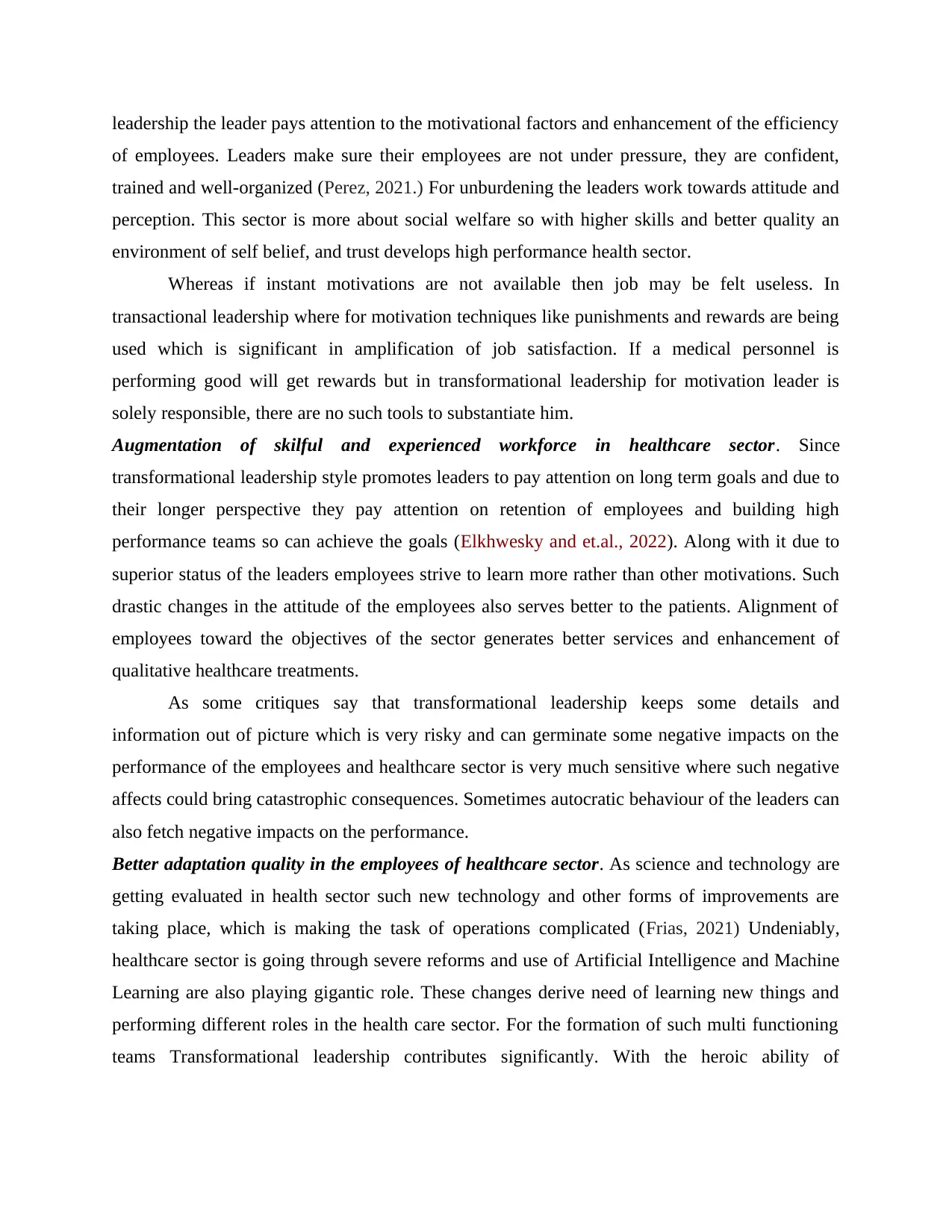
leadership the leader pays attention to the motivational factors and enhancement of the efficiency
of employees. Leaders make sure their employees are not under pressure, they are confident,
trained and well-organized (Perez, 2021.) For unburdening the leaders work towards attitude and
perception. This sector is more about social welfare so with higher skills and better quality an
environment of self belief, and trust develops high performance health sector.
Whereas if instant motivations are not available then job may be felt useless. In
transactional leadership where for motivation techniques like punishments and rewards are being
used which is significant in amplification of job satisfaction. If a medical personnel is
performing good will get rewards but in transformational leadership for motivation leader is
solely responsible, there are no such tools to substantiate him.
Augmentation of skilful and experienced workforce in healthcare sector. Since
transformational leadership style promotes leaders to pay attention on long term goals and due to
their longer perspective they pay attention on retention of employees and building high
performance teams so can achieve the goals (Elkhwesky and et.al., 2022). Along with it due to
superior status of the leaders employees strive to learn more rather than other motivations. Such
drastic changes in the attitude of the employees also serves better to the patients. Alignment of
employees toward the objectives of the sector generates better services and enhancement of
qualitative healthcare treatments.
As some critiques say that transformational leadership keeps some details and
information out of picture which is very risky and can germinate some negative impacts on the
performance of the employees and healthcare sector is very much sensitive where such negative
affects could bring catastrophic consequences. Sometimes autocratic behaviour of the leaders can
also fetch negative impacts on the performance.
Better adaptation quality in the employees of healthcare sector. As science and technology are
getting evaluated in health sector such new technology and other forms of improvements are
taking place, which is making the task of operations complicated (Frias, 2021) Undeniably,
healthcare sector is going through severe reforms and use of Artificial Intelligence and Machine
Learning are also playing gigantic role. These changes derive need of learning new things and
performing different roles in the health care sector. For the formation of such multi functioning
teams Transformational leadership contributes significantly. With the heroic ability of
of employees. Leaders make sure their employees are not under pressure, they are confident,
trained and well-organized (Perez, 2021.) For unburdening the leaders work towards attitude and
perception. This sector is more about social welfare so with higher skills and better quality an
environment of self belief, and trust develops high performance health sector.
Whereas if instant motivations are not available then job may be felt useless. In
transactional leadership where for motivation techniques like punishments and rewards are being
used which is significant in amplification of job satisfaction. If a medical personnel is
performing good will get rewards but in transformational leadership for motivation leader is
solely responsible, there are no such tools to substantiate him.
Augmentation of skilful and experienced workforce in healthcare sector. Since
transformational leadership style promotes leaders to pay attention on long term goals and due to
their longer perspective they pay attention on retention of employees and building high
performance teams so can achieve the goals (Elkhwesky and et.al., 2022). Along with it due to
superior status of the leaders employees strive to learn more rather than other motivations. Such
drastic changes in the attitude of the employees also serves better to the patients. Alignment of
employees toward the objectives of the sector generates better services and enhancement of
qualitative healthcare treatments.
As some critiques say that transformational leadership keeps some details and
information out of picture which is very risky and can germinate some negative impacts on the
performance of the employees and healthcare sector is very much sensitive where such negative
affects could bring catastrophic consequences. Sometimes autocratic behaviour of the leaders can
also fetch negative impacts on the performance.
Better adaptation quality in the employees of healthcare sector. As science and technology are
getting evaluated in health sector such new technology and other forms of improvements are
taking place, which is making the task of operations complicated (Frias, 2021) Undeniably,
healthcare sector is going through severe reforms and use of Artificial Intelligence and Machine
Learning are also playing gigantic role. These changes derive need of learning new things and
performing different roles in the health care sector. For the formation of such multi functioning
teams Transformational leadership contributes significantly. With the heroic ability of
⊘ This is a preview!⊘
Do you want full access?
Subscribe today to unlock all pages.

Trusted by 1+ million students worldwide
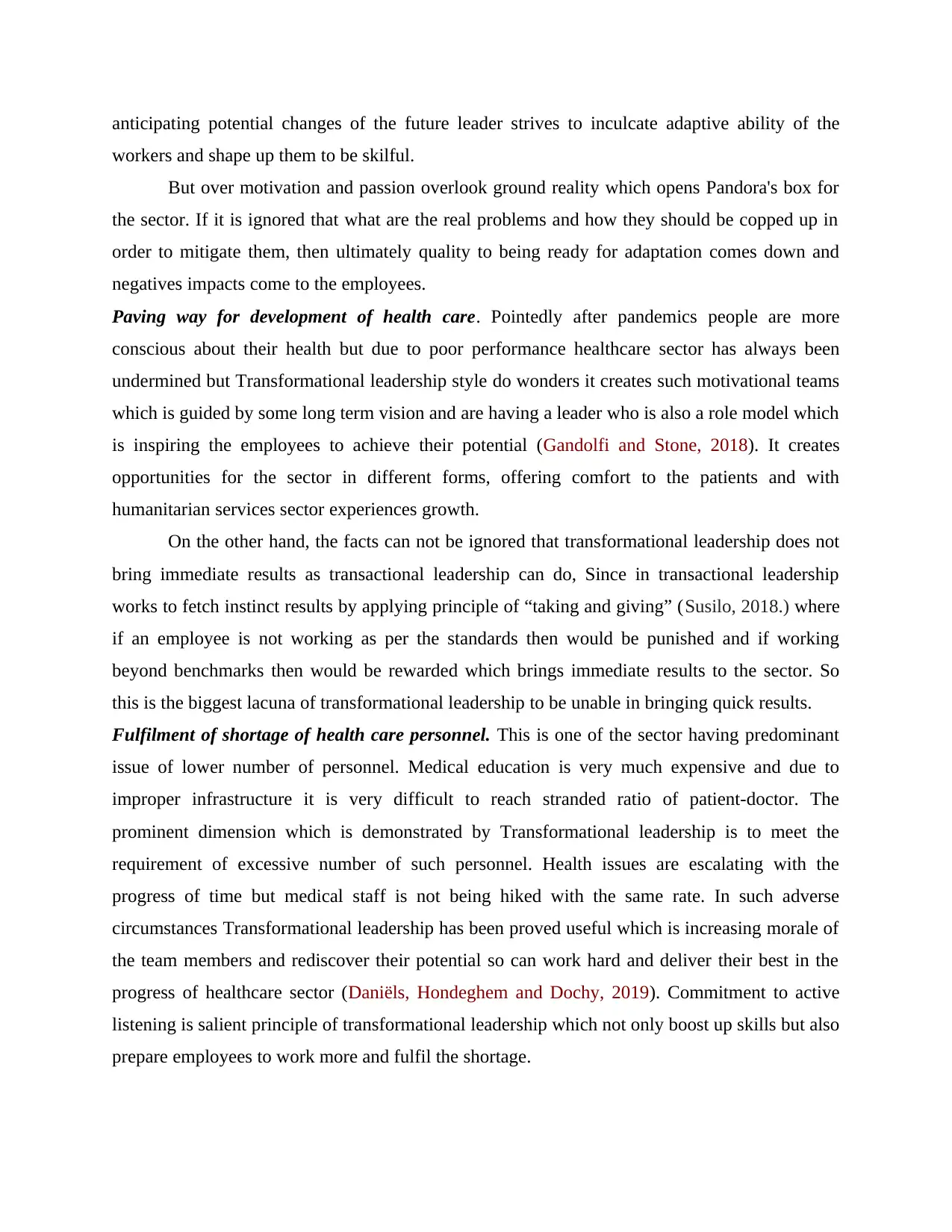
anticipating potential changes of the future leader strives to inculcate adaptive ability of the
workers and shape up them to be skilful.
But over motivation and passion overlook ground reality which opens Pandora's box for
the sector. If it is ignored that what are the real problems and how they should be copped up in
order to mitigate them, then ultimately quality to being ready for adaptation comes down and
negatives impacts come to the employees.
Paving way for development of health care. Pointedly after pandemics people are more
conscious about their health but due to poor performance healthcare sector has always been
undermined but Transformational leadership style do wonders it creates such motivational teams
which is guided by some long term vision and are having a leader who is also a role model which
is inspiring the employees to achieve their potential (Gandolfi and Stone, 2018). It creates
opportunities for the sector in different forms, offering comfort to the patients and with
humanitarian services sector experiences growth.
On the other hand, the facts can not be ignored that transformational leadership does not
bring immediate results as transactional leadership can do, Since in transactional leadership
works to fetch instinct results by applying principle of “taking and giving” (Susilo, 2018.) where
if an employee is not working as per the standards then would be punished and if working
beyond benchmarks then would be rewarded which brings immediate results to the sector. So
this is the biggest lacuna of transformational leadership to be unable in bringing quick results.
Fulfilment of shortage of health care personnel. This is one of the sector having predominant
issue of lower number of personnel. Medical education is very much expensive and due to
improper infrastructure it is very difficult to reach stranded ratio of patient-doctor. The
prominent dimension which is demonstrated by Transformational leadership is to meet the
requirement of excessive number of such personnel. Health issues are escalating with the
progress of time but medical staff is not being hiked with the same rate. In such adverse
circumstances Transformational leadership has been proved useful which is increasing morale of
the team members and rediscover their potential so can work hard and deliver their best in the
progress of healthcare sector (Daniëls, Hondeghem and Dochy, 2019). Commitment to active
listening is salient principle of transformational leadership which not only boost up skills but also
prepare employees to work more and fulfil the shortage.
workers and shape up them to be skilful.
But over motivation and passion overlook ground reality which opens Pandora's box for
the sector. If it is ignored that what are the real problems and how they should be copped up in
order to mitigate them, then ultimately quality to being ready for adaptation comes down and
negatives impacts come to the employees.
Paving way for development of health care. Pointedly after pandemics people are more
conscious about their health but due to poor performance healthcare sector has always been
undermined but Transformational leadership style do wonders it creates such motivational teams
which is guided by some long term vision and are having a leader who is also a role model which
is inspiring the employees to achieve their potential (Gandolfi and Stone, 2018). It creates
opportunities for the sector in different forms, offering comfort to the patients and with
humanitarian services sector experiences growth.
On the other hand, the facts can not be ignored that transformational leadership does not
bring immediate results as transactional leadership can do, Since in transactional leadership
works to fetch instinct results by applying principle of “taking and giving” (Susilo, 2018.) where
if an employee is not working as per the standards then would be punished and if working
beyond benchmarks then would be rewarded which brings immediate results to the sector. So
this is the biggest lacuna of transformational leadership to be unable in bringing quick results.
Fulfilment of shortage of health care personnel. This is one of the sector having predominant
issue of lower number of personnel. Medical education is very much expensive and due to
improper infrastructure it is very difficult to reach stranded ratio of patient-doctor. The
prominent dimension which is demonstrated by Transformational leadership is to meet the
requirement of excessive number of such personnel. Health issues are escalating with the
progress of time but medical staff is not being hiked with the same rate. In such adverse
circumstances Transformational leadership has been proved useful which is increasing morale of
the team members and rediscover their potential so can work hard and deliver their best in the
progress of healthcare sector (Daniëls, Hondeghem and Dochy, 2019). Commitment to active
listening is salient principle of transformational leadership which not only boost up skills but also
prepare employees to work more and fulfil the shortage.
Paraphrase This Document
Need a fresh take? Get an instant paraphrase of this document with our AI Paraphraser
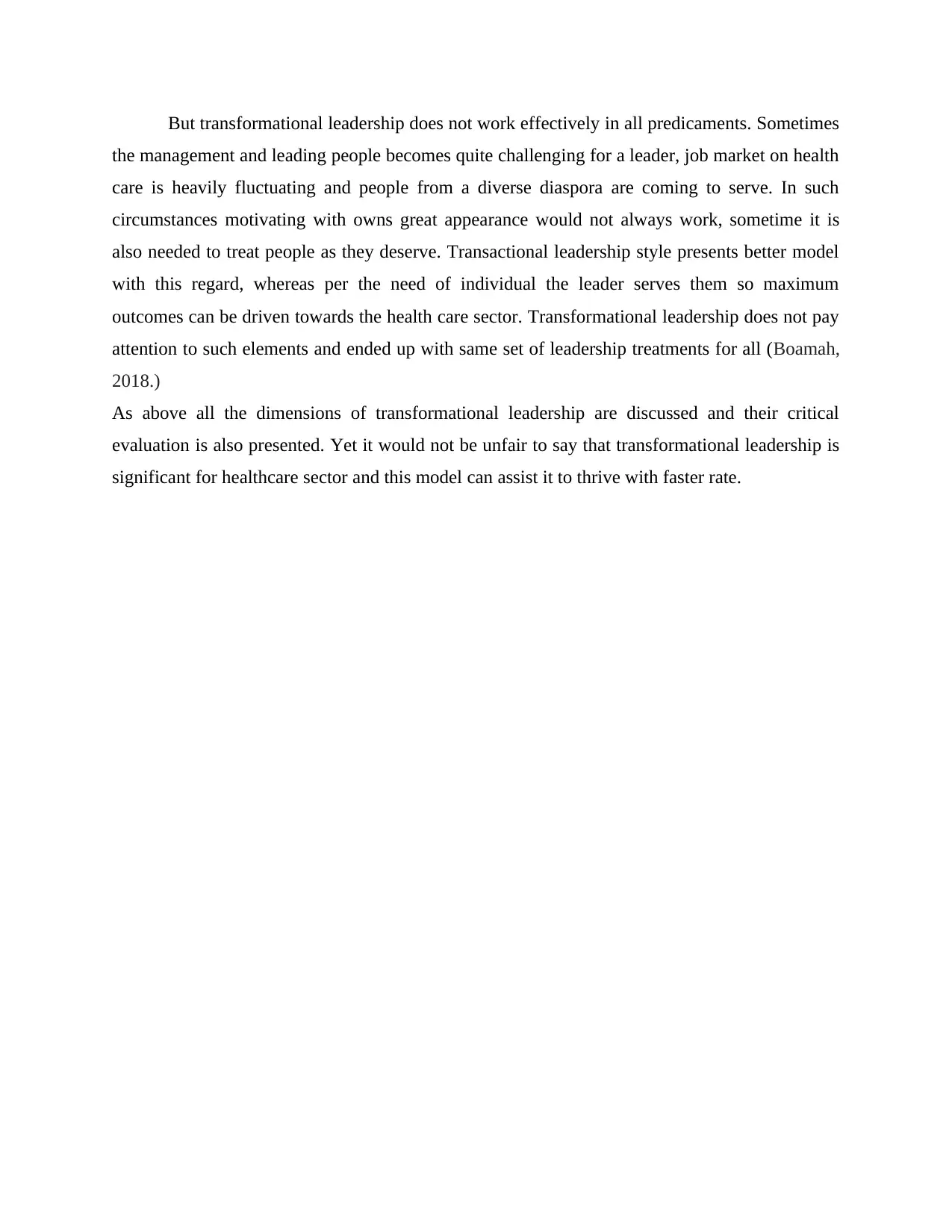
But transformational leadership does not work effectively in all predicaments. Sometimes
the management and leading people becomes quite challenging for a leader, job market on health
care is heavily fluctuating and people from a diverse diaspora are coming to serve. In such
circumstances motivating with owns great appearance would not always work, sometime it is
also needed to treat people as they deserve. Transactional leadership style presents better model
with this regard, whereas per the need of individual the leader serves them so maximum
outcomes can be driven towards the health care sector. Transformational leadership does not pay
attention to such elements and ended up with same set of leadership treatments for all (Boamah,
2018.)
As above all the dimensions of transformational leadership are discussed and their critical
evaluation is also presented. Yet it would not be unfair to say that transformational leadership is
significant for healthcare sector and this model can assist it to thrive with faster rate.
the management and leading people becomes quite challenging for a leader, job market on health
care is heavily fluctuating and people from a diverse diaspora are coming to serve. In such
circumstances motivating with owns great appearance would not always work, sometime it is
also needed to treat people as they deserve. Transactional leadership style presents better model
with this regard, whereas per the need of individual the leader serves them so maximum
outcomes can be driven towards the health care sector. Transformational leadership does not pay
attention to such elements and ended up with same set of leadership treatments for all (Boamah,
2018.)
As above all the dimensions of transformational leadership are discussed and their critical
evaluation is also presented. Yet it would not be unfair to say that transformational leadership is
significant for healthcare sector and this model can assist it to thrive with faster rate.
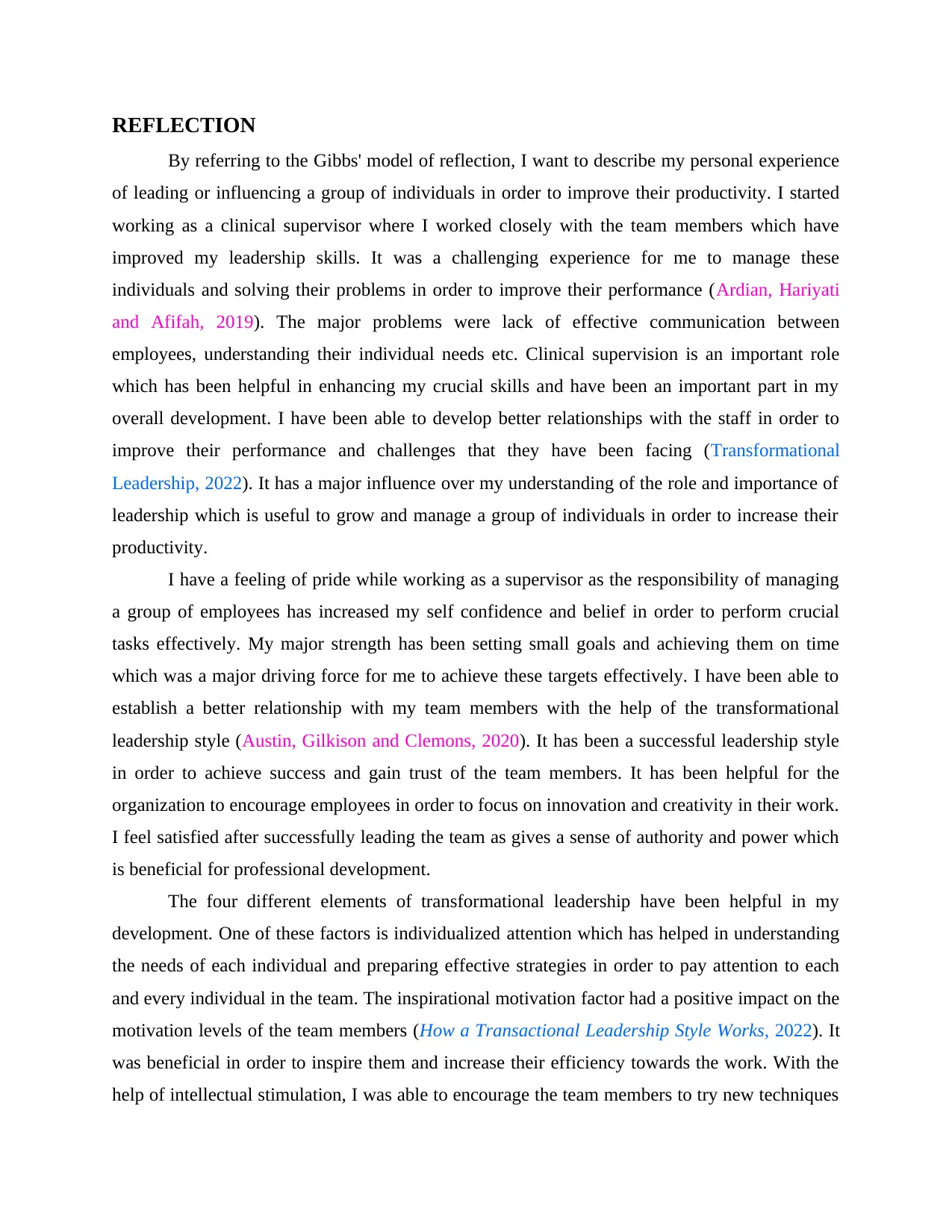
REFLECTION
By referring to the Gibbs' model of reflection, I want to describe my personal experience
of leading or influencing a group of individuals in order to improve their productivity. I started
working as a clinical supervisor where I worked closely with the team members which have
improved my leadership skills. It was a challenging experience for me to manage these
individuals and solving their problems in order to improve their performance (Ardian, Hariyati
and Afifah, 2019). The major problems were lack of effective communication between
employees, understanding their individual needs etc. Clinical supervision is an important role
which has been helpful in enhancing my crucial skills and have been an important part in my
overall development. I have been able to develop better relationships with the staff in order to
improve their performance and challenges that they have been facing (Transformational
Leadership, 2022). It has a major influence over my understanding of the role and importance of
leadership which is useful to grow and manage a group of individuals in order to increase their
productivity.
I have a feeling of pride while working as a supervisor as the responsibility of managing
a group of employees has increased my self confidence and belief in order to perform crucial
tasks effectively. My major strength has been setting small goals and achieving them on time
which was a major driving force for me to achieve these targets effectively. I have been able to
establish a better relationship with my team members with the help of the transformational
leadership style (Austin, Gilkison and Clemons, 2020). It has been a successful leadership style
in order to achieve success and gain trust of the team members. It has been helpful for the
organization to encourage employees in order to focus on innovation and creativity in their work.
I feel satisfied after successfully leading the team as gives a sense of authority and power which
is beneficial for professional development.
The four different elements of transformational leadership have been helpful in my
development. One of these factors is individualized attention which has helped in understanding
the needs of each individual and preparing effective strategies in order to pay attention to each
and every individual in the team. The inspirational motivation factor had a positive impact on the
motivation levels of the team members (How a Transactional Leadership Style Works, 2022). It
was beneficial in order to inspire them and increase their efficiency towards the work. With the
help of intellectual stimulation, I was able to encourage the team members to try new techniques
By referring to the Gibbs' model of reflection, I want to describe my personal experience
of leading or influencing a group of individuals in order to improve their productivity. I started
working as a clinical supervisor where I worked closely with the team members which have
improved my leadership skills. It was a challenging experience for me to manage these
individuals and solving their problems in order to improve their performance (Ardian, Hariyati
and Afifah, 2019). The major problems were lack of effective communication between
employees, understanding their individual needs etc. Clinical supervision is an important role
which has been helpful in enhancing my crucial skills and have been an important part in my
overall development. I have been able to develop better relationships with the staff in order to
improve their performance and challenges that they have been facing (Transformational
Leadership, 2022). It has a major influence over my understanding of the role and importance of
leadership which is useful to grow and manage a group of individuals in order to increase their
productivity.
I have a feeling of pride while working as a supervisor as the responsibility of managing
a group of employees has increased my self confidence and belief in order to perform crucial
tasks effectively. My major strength has been setting small goals and achieving them on time
which was a major driving force for me to achieve these targets effectively. I have been able to
establish a better relationship with my team members with the help of the transformational
leadership style (Austin, Gilkison and Clemons, 2020). It has been a successful leadership style
in order to achieve success and gain trust of the team members. It has been helpful for the
organization to encourage employees in order to focus on innovation and creativity in their work.
I feel satisfied after successfully leading the team as gives a sense of authority and power which
is beneficial for professional development.
The four different elements of transformational leadership have been helpful in my
development. One of these factors is individualized attention which has helped in understanding
the needs of each individual and preparing effective strategies in order to pay attention to each
and every individual in the team. The inspirational motivation factor had a positive impact on the
motivation levels of the team members (How a Transactional Leadership Style Works, 2022). It
was beneficial in order to inspire them and increase their efficiency towards the work. With the
help of intellectual stimulation, I was able to encourage the team members to try new techniques
⊘ This is a preview!⊘
Do you want full access?
Subscribe today to unlock all pages.

Trusted by 1+ million students worldwide
1 out of 17
Related Documents
Your All-in-One AI-Powered Toolkit for Academic Success.
+13062052269
info@desklib.com
Available 24*7 on WhatsApp / Email
![[object Object]](/_next/static/media/star-bottom.7253800d.svg)
Unlock your academic potential
Copyright © 2020–2025 A2Z Services. All Rights Reserved. Developed and managed by ZUCOL.





